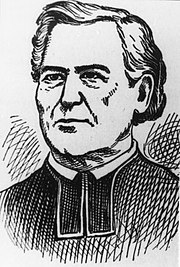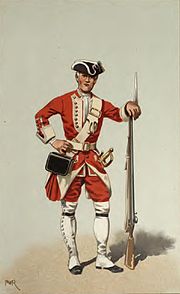The Siege of Annapolis Royal (also known as the Siege of Fort Anne) in 1744 involved two of four attempts by the French, along with their Acadian and native allies, to regain the capital of Nova Scotia/Acadia, Annapolis Royal, during King George's War. The Siege is noted for Governor of Nova Scotia Paul Mascarene successfully defending the last British outpost in the colony and for the first arrival of New England Ranger John Gorham to Nova Scotia.
Historical context[]
The conquest of Acadia by Great Britain began with the 1710 capture of the provincial capital, Port Royal. In the 1713 Treaty of Utrecht, France formally ceded Acadia to Britain. However, there was disagreement about the provincial boundaries, and some Acadians also resisted British rule. With renewed war imminent in 1744, the leaders of New France formulated plans to retake what the British called Nova Scotia with an assault on the capital, which the British had renamed Annapolis Royal.
With the outbreak of the War of the Austrian Succession (whose North American theater is also known as King George's War) in Europe, the French colony of Île-Royale (present-day Cape Breton Island) received the news first and took immediate action. French officer François Dupont Duvivier led an attack on raided the British outpost at Canso, capturing the small garrison of the 40th Regiment of Foot without incident. Du Vivier's next plan was to take the only other British outpost in Nova Scotia, Annapolis Royal.
First stage[]
The governor of Ile Royal, Jean-Baptiste-Louis Le Prévost Duquesnel, lacking the troop strength to attack Annapolis Royal, recruited the militant French priest Jean-Louis Le Loutre to raise a force of Acadians and Indians to assault the Nova Scotian capital. Le Loutre raised a force of 300 Mi'kmaq and Maliseet, and arrived before Annapolis Royal's main fortification, Fort Anne, on 12 July 1744. The attackers killed two soldiers, and the assault ended after three days with the arrival of British ships from Boston.[1] Le Loutre withdrew to Grand Pre to await the arrival of DuVivier.
Second stage[]

François Dupont Duvivier, who had led the Canso raid, led the second siege attempt against Fort Anne, with a force of 200 troops. Duvivier arrived at Fort Anne on 6 September 1744. The first night he erected shelters. The next morning he approached the fort and the Governor of Nova Scotia, Paul Mascarene responded by firing a cannon, which lead Duvivier to withdraw. That night Duvivier sent small parties to the fort which lead to skimishing the whole night. On the morning of 7 September, Duvivier sent his younger brother to the fort under a flag of truce carrying a message that said British resistance was futile. Paul Mascarene, rejected the surrender demand, and replied that naval reinforcements were on the way and that if the French surrendered they would receive benign treatment. Duvivier gave them twenty four hours before he said he would attack at noon on 8 September.
Duvivier waited until 9 September to begin the siege. The French troops and Mi'kmaq attacked the wall of the fort each night and conducted daily raids around the ramparts. On 15 September, Duvivier again asked Mascarene to surrender which they refused. They continued to fight. On 25 September British sergeant was killed and a private was wounded.[2] During the siege Duvivier waited weeks for French vessels to arrive to reinforce his attack, while Mascarene awaited for support from Boston. On September 26, New England Ranger John Gorham arrived with 50 Mohawk rangers. Gorham's rangers brough the total manpower of the garrison up to about 270. A few days later, Gorham led his native rangers in a surprise raid on a nearby Mi'kmaq encampment. They killed and mutilated the bodies of women and children.[3] The Mi'kmaq withdrew and Duvivier was forced to retreat back to Grand Pre on 5 October.[4] (The following year, Mi'kmaq sought revenge on Gorham's Rangers by torturing the rangers they took prisoner in the siege of Annapolis Royal.[5] )
Consequences[]

Private, 40th Regiment of Foot, Nova Scotia, 1742
From this siege, the French learned that until they could send an army with siege guns and cannon against the capital, there was little to gain from exposing their forces in a siege. A successful French campaign would depend on the navy's ability to supply the army. The French also learned that they could not rely on the majority of Acadians to take up arms against the British.[6] On 20 October 1744 the government of Massachusetts officially declared war on the Mi'kmaq. A bounty was offered for the head of any man, woman or child.[7]
The French made two further attempts, both unsuccessful, to regain Annapolis Royal during the war.
See also[]
References[]
Endnotes
- ↑ Faragher, John Mack, A Great and Noble Scheme New York; W. W. Norton & Company, 2005. pp. 217-218
- ↑ John Grenier. The Edge of Empire: War in Nova Scotia 1710-1760. 2008.pp. 116-118
- ↑ Pierre Malliard. An account of the customs and manners of the MicMakis and Marichetts Savage Nations
- ↑ Faragher, John Mack, A Great and Noble Scheme New York; W. W. Norton & Company, 2005. pp. 219-220
- ↑ Journal of William Pote
- ↑ John Grenier. The Edge of Empire: War in Nova Scotia 1710-1760. 2008.p. 119
- ↑ Geoffery Plank. An Unsettled Conquest. University of Pennsylvania. 2001. p. 110
Secondary Sources
- Grenier, John. (2008). The Far Reaches of Empire: War in Nova Scotia 1710-1760. University of Oklahoma Press
- Kingsford, William. The History of Canada, Volume 3
- Johnson, Rossiter. A history of the French wars: ending in the conquest of Canada, Volume 2
- Murdoch, Beamish. A history of Nova Scotia, or Acadie, Volume 2
- W.O. Raymond. The old Meductic Fort and the Indian chapel of Saint Jean Baptiste: paper read before the New Brunswick Historical Society (1897)
- Bernard Pothier. The Siege of Annapolis Royal, 1744. The Nova Scotia Historical Review. 59-71
Coordinates: 44°44′28.1″N 65°30′40.8″W / 44.741139°N 65.511333°W
The original article can be found at Siege of Annapolis Royal (1744) and the edit history here.
